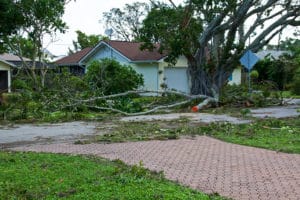

Storm Damage Repair
When severe storms and hurricanes cause damage to your business building or your home, the effects can be devastating. You may experience serious issues from mold to structural damage. But thankfully, our team here at Restore Remodel and Renew specializes in providing compassionate and professional storm damage restoration services to our customers. Our goal is to quickly and safely provide you our emergency services so that you can get back to your normal life.
We provide a wide variety of storm damage repairs to our customers. All of the emergency storm damage restoration services that we provide help you deal with all kinds of storm-related damages, including those caused by:
- Flooding
- Lightning Strikes
- Thunderstorms
- Tornadoes
- High Wind
- Hurricanes
- Hail Storms
- Freezing Temperatures
Flood Damages
Storm-related flooding can cause massive damage to a home. One way that floods can damage your home is by loosening or buckling up your floors. Another way that floods can damage your home is by creating cracks in your home’s roof and foundation.
Electrical Flooding Damage
Flooding can also cause dangerous electrical damage that can go from the outside of your home to the inside of your home. For example, you may have broken or frayed electrical wires inside your home after a flood. Touching such electrical wiring when wet can cause negative effects, including electrocuting. Therefore, it is important to contact an electrician immediately if you notice electrical damage on or in your home after a flood.
Flooding Damage to Appliances
It is easy to damage appliances such as refrigerators, stoves, ovens, toasters, heating and air conditioning systems, water heaters, etc. through flooding. Flooded household appliances are very dangerous to use as well. Therefore, after there is flood damage to your appliances, you should call a handy-man professional and electrician to inspect the appliances prior to using them again.
To be on the safe side, you should just turn off your home’s electricity entirely after noticing flooding damage to your appliances. Once you shut down the electricity inside your home and home appliances, make sure to throw away any spoilable food that is in any of these appliances, in particular, your refrigerator.
Flooding Damage to Flooring and Installation
Food isn’t the only thing that flooding can spoil in your house. It is common for mold and mildew to grow on any surface that has been wet for too long. Therefore, everything from your home’s drywall to your home’s flooring and installation is susceptible to developing mold and mildew and needing storm damage repairs.
Flooding Damage to Personal Property
Personal items in your home, such as clothing and furniture, can also develop mold and mildew after flooding. To help minimize any growth of mold or mildew on your personal items, dry them out as soon as possible. Once your electrician deems it safe to use your home’s electricity, you should also dry out your entire home to the best of your abilities by turning on the air ventilation system, any fans, and any dehumidifiers that you have in your house.
Flooding Damage to Septic Tanks and Drinking Water
After a flood, it is very important to have your septic tanks and drinking water and wells inspected. This is because septic tanks can become clogged with debris after floods. Also, flooding can cause contamination in wells and your drinking water that could cause it to need storm damage restorations.
Lightning Strike Damage
The amount of damage that lightning strikes can cause on a home is huge. In fact, lightning strikes technically do not even have to directly hit your home to cause massive home damage. If a lightning strike is close enough, it can connect with a wire or pipe and get into your home.
You can decrease the amount of damage that a lightning strike can cause on your home by plugging your electronic devices into surge protectors. This includes your phone, cable, internet, and TV wiring.
Lightning strikes can come into contact with wiring behind walls. When they do, they can cause the wiring in the wall to catch on fire. Lightning strike damage to home automation equipment and large appliances can also be huge due to the fact that they are now high-tech and contain control boards and embedded electronics and digital displays. In fact, you can find vulnerable internal circuit boards and electronics in everything from stoves and ovens, to refrigerators, to air conditioners, electric vehicles, garage door openers, and more. To help rectify this issue, you can purchase whole-house surge protection.
More About Lighting Damage
There are whole-house surge protection devices that you can integrate with the circuit panel of a large appliance to stop the surge of a lightning strike at that entry point. These whole-house surge protectors can also protect the home in case lightning strikes a power pole. Instead, the surge protection will cause any lightning strike surges to go into the meter and the protected circuit panel. Surge protectors even protect the home from unexpected surges from the electrical grid.
If lightning strikes enter the home from anywhere outside of the surge-protected circuit panel, it will continue to cause damage until it reaches the surge protector itself. To be on the safe side, unplug your electronic appliance and devices whenever it is storming and there is thundering and lightning close by to minimize the chances that they’ll need storm damage repairs.
Thunderstorm Damage
Thunderstorms are rain showers with lightning. A severe thunderstorm is a thunderstorm that also contains hail that is 1-inch or more in diameter and/or straight-line winds of 58 mph or more. Storms with cooled rain air descending can cause winds that are as fast as 100 mph. Winds as fast as 100 mph are also known as straight-line gust winds.
These heavy thunderstorm winds and rain can do massive damage to homes. This damage could cause you to need large amounts of storm damage restoration. In fact, thunderstorms with sudden downbursts of strong winds are strong enough to move mobile homes, rip roofs off of houses, and topple trees over.
Severe thunderstorms with 1-inch hail can break windows and cause significant damage to cars and homes. When thunderstorms become strong enough, they can turn into tornadoes.
Tornado Damage
Similar to severe thunderstorms, tornadoes are strong enough to rip off roofs, topple over trees, and terrorize mobile homes. Tornadoes are also strong enough to shatter windows and closing doors and break and knock off garage doors.
Tornadoes can even lift and hurl objects like cars, telephone poles, and mailboxes and throw them into houses. They can also punch holes into brick walls and damage sidings.
High Wind Damage
High winds of up to 25 mph are strong enough to cause damage to items. When winds are as fast as 25 to 50 mph, they can damage shingles. From 50 to 75 mph, they can break off shingles, lift up tree limbs and debris, and topple over trees. It is when winds are within this range that they technically are categorized as damaging and high.
High winds from 75-100 mph can destroy mobile homes and lift and throw large objects like vehicles into homes. When winds are higher than 100 mph, they can damage even the sturdiest of homes. Thus, natural disasters with high winds will almost guarantee that you’ll need storm damage repairs on your home. Despite how damaging high winds of 100 mph are, on the hurricane scale, 100 mph winds are only considered a category 2 hurricane.
Hurricane Damage
Category 1 hurricanes, or hurricanes with winds of 74-95 mph, are strong enough to break tree branches and uproot small trees. Hurricanes of as low as category 1 are also strong enough to cause a power outage.
Category 2 hurricanes are hurricanes with 96-110 mph winds. Category 2 hurricanes are where property damage really begins. Category 2 hurricanes are strong enough to damage your home’s roof, gutter, and sides.
Category 3 hurricanes are hurricanes with 111-129 mph winds. These hurricanes can rip off your roof deck and flood your homes.
Category 4 hurricanes, or hurricanes with 130-156 mph winds, can completely detach your roof and siding from your home. Category 4 hurricanes can also uproot large roots and knock down power lines.
Category 5 is the highest category that hurricanes can reach. These hurricanes have winds that are 157 mph or more. Category 5 hurricanes are strong enough to completely destroy a sturdy house. Thus, people should evacuate their homes whenever there is a category 5 hurricane in their area.
Hail Storm Damage
Hail storms can put dents and minor damage on your roof. They can also break and fracture the shingles on your roof. Although the damage to roofs that hail storms can cause are minor, hail storms are strong enough to shatter and break glass windows and doors. In fact, wind-driven hail in hail storms can split your house’s siding. Driving hailstorms can also damage your air conditioning units and your chimneys and flue vents.
Freezing Temperatures
Freezing temperatures can cause more damage to your homes than you think. Condensation from ice and snow along with the freezing temperatures themselves can cause ice dams on your roof that lead to roof leaks. The ice and snow that freezing temperatures cause can also block your gutters and create ice dams.
The icicles that freezing temperatures cause can also put stress on your roof. Strong freezing winds can even loosen the shingles on your roof.
When freezing temperatures fluctuate, it can cause the caulk on the inside of your windows to crack and gradually pull off, thus causing these windows to need storm damage repairs. Fluctuating freezing temperatures are also known to cause chimneys to expand and contract. This, in turn, causes chimneys to develop cracks. Over time, this could cause water to get behind the mortar and freezer and cause it to fail.
Constantly shoveling and scraping ice off your driveway due to freezing temperatures and the snow that they bring can cause chips and cracks to your driveway. The same is true for your front steps. On top of this, frozen tree limbs can easily break off and fall on your roof, sides, or power lines. This could cause you to need storm damage restorations.
More About Damage from Freezing Temperatures
When freezing temperatures hit extreme levels, you are in danger of having your plumbing pipes freeze and burst. Extreme freezing temperatures can also cause the frames around your doors to become soft and damp. Soft and damp door frames can create wood rot, which then leads to termites. These door frames can also cause mold or mildew to form. Mold and mildew, along with discoloration, can also form on decks that are exposed to freezing temperatures.
Overtime, melting snow due to freezing temperatures could cause water to flood your basement. Freezing temperatures can even cause sump pumps hoses to freeze and get clogged with ice. This could cause flooding in your house.
Vinyl siding can become brittle and crack during the wintertime. This is due to the expansion and contracting of vinyl siding when freezing temperatures fluctuate. As a result, water can seep behind those vinyl sidings and cause structural damage.
The refreezing of the ground can even cause the soil to shift and move underneath your home’s concrete foundation. This, in turn, causes cracks and drainage issues. Cracks, along with shrinkage, also occur in plaster walls during the winter.
Restore.Remodel.Renew. Has Got Your Back
Ultimately, natural disasters can cause massive damage to your home or commercial building that could cause you to need storm damage repairs. Unfortunately, we cannot avoid natural disasters. That is why you should have access to a company that provides affordable professional residential and commercial emergency restoration services.
Thankfully, Restore Remodel Renew is that company! To learn about the specific storm damage restoration services that we provide, contact us today.
